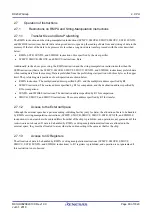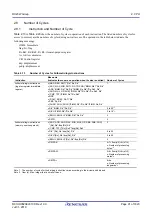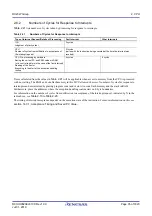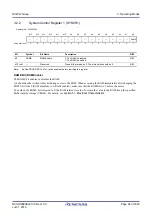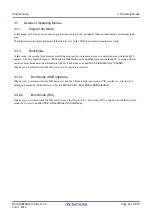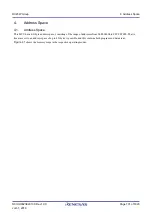
R01UH0823EJ0100 Rev.1.00
Page 104 of 1823
Jul 31, 2019
RX23W Group
5. I/O Registers
Longword-size I/O registers
MOV.L #SFR_ADDR, R1
MOV.L #SFR_DATA, [R1]
CMP [R1].L, R1
;; Next process
If multiple registers are written to and a subsequent instruction should be executed after the write operations are entirely
completed, only read the I/O register that was last written to and execute the operation using the value; it is not necessary
to read or execute operation for all the registers that were written to.
(3) Number of Access Cycles to I/O Registers
For numbers of clock cycles for access to I/O registers, see
Table 5.1, List of I/O Registers (Address Order)
.
The number of access cycles to I/O registers is obtained by following equation.
Number of access cycles to I/O registers = Number of bus cycles for internal main bus 1 +
Number of divided clock synchronization
Number of bus cycles for internal peripheral bus 1 to 6
The number of bus cycles of internal peripheral bus 1 to 6 differs according to the register to be accessed.
When peripheral functions connected to internal peripheral bus 2 to 6 are accessed, the number of divided clock
synchronization cycles is added.
The number of divided clock synchronization cycles differs depending on the frequency ratio between ICLK and PCLK
(or FCLK) or bus access timing.
In the peripheral function unit, when the frequency ratio of ICLK is equal to or greater than that of PCLK (or FCLK), the
sum of the number of bus cycles for internal main bus 1 and the number of the divided clock synchronization cycles will
be one cycle of PCLK (or FCLK) at a maximum. Therefore, one PCLK (or FCLK) has been added to the number of
access cycles shown in
.
When the frequency ratio of ICLK is lower than that of PCLK (or FCLK), the subsequent bus access is started from the
ICLK cycle following the completion of the access to the peripheral functions. Therefore, the access cycles are described
on an ICLK basis.
Note 1. This applies to the number of cycles when the access from the CPU does not conflict with the instruction fetching
to the external memory or bus access from the different bus master (DMAC or DTC).
(4) Restrictions in Relation to RMPA and String-Manipulation Instructions
The allocation of data to be handled by RMPA or string-manipulation instructions to I/O registers is prohibited, and
operation is not guaranteed if this restriction is not observed.
(5) Notes on Sleep Mode and Mode Transitions
During sleep mode or mode transitions, do not write to the system control related registers (indicated by 'SYSTEM' in the
Module Symbol column in
Table 5.1, List of I/O Registers (Address Order)
).

